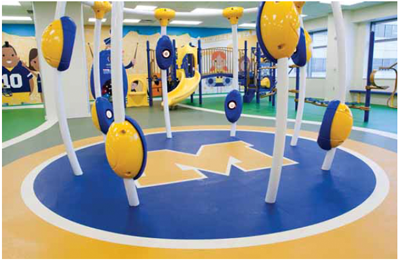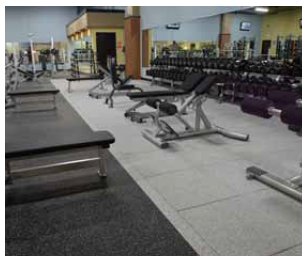Rubber Underfoot
Learning Objectives:
- Identify how rubber flooring’s limited cleaning and maintenance requirements translate into a high life-cycle cost value.
- Differentiate how rubber flooring meets stringent IAQ requirements, as compared to other flooring types.
- Identify common recycled content within rubber flooring and its end-of-life recyclable uses.
- Appreciate the level of foot, leg and back support afforded by rubber flooring, as well as slip prevention.
Credits:
Once limited to weight rooms and playgrounds, the virtues of rubber flooring have catapulted the product into a wider variety of applications including healthcare, education, corporate and recreational facilities.
With limited maintenance needs, a long life span, low life-cycle costs, underfoot comfort, good sound absorption properties and excellent slip resistance, rubber has become a more compelling resilient flooring choice. Made from recycled materials and being recyclable, in addition to meeting high IAQ standards, rubber’s sustainable qualities are impressive as well.
And when it comes to aesthetics, rubber has come a long way. “Once available in every shade as long as it was black, manufacturers now produce rubber flooring in scores of different colors,” says Stephen Ashkin, president, The Ashkin Group, Bloomington, Ind. “Some colors can be transitioned, fading from one color to another adding unique interest and design flexibility.”

IMAGE COURTESY OF ECORE
As the only product capable of meeting the hospital’s strict indoor air quality standards, rubber flooring was selected to pad an indoor playground at the University of Michigan Health System’s newest facility the Von Voigtlander Women’s Hospital in Ann Arbor.
Keep It Clean
Perhaps one of rubber flooring’s biggest claims to fame is the fact that it requires considerably less cleaning and maintenance than other flooring types. Essentially, there’s no finishing, waxing or sealing. Just a daily sweep and mop, and if desired, a one-step condition and polish every couple of weeks or so. The polish lends a nice sheen and makes the floor appear as if it’s been waxed.
In fact, Sylvia White, MS, manager of custodial services, Southern Polytechnic State University, Marietta, Ga., estimates that the necessary time and effort to maintain rubber flooring systems is about half of that required by other materials.
At this private college, rubber flooring is installed in many of the entryways: the police department, the wellness center, weightlifting area and some vending machine locations.
Meanwhile at Metrolina Regional Scholar’s Academy in Charlotte, N.C., rubber flooring is used extensively throughout the school in assorted colorful patterns and designs.
“We chose this flooring because we are trying to support a strong environmental ethic for our school community. The idea of no stripping with chemicals, waxing or needing to use other unpleasant cleaning products was a major determining factor in our selection of the rubber flooring,” says academy director Marie E. Peine, Ph.D. “The flooring makes the building look and sound so much brighter.”
Similarly, at Urge Fitness in Ewing, N.J., ECORE rubber flooring in the free weight and cardio areas, spin class rooms and general exercise room lends a fresh look to the fitness center, especially after cleaning.
“We just go in there, hit it with a mop and one, two, three… once the water hits, it looks like brand new. It couldn’t be easier,” says Shayne Michaelis, director of operations, Urge Fitness.
As far as the cleaning itself, White recommends microfiber broom and mop products as they require considerably less water and the floors dry faster.
“The microfiber product grabs the dirt and then releases it when you wash the mop,” she explains. “Consequently, you can get a lot of uses out of microfiber.”
And because rubber has a nonporous and dirt-repellant surface, all the dust and dirt stays on the top, so it’s easier for the microfiber to pick up. This quality also makes rubber an ideal application for fitness rooms as the area can still be properly cleaned without having to move the heavy exercise equipment.
While Ashkin agrees that these flat mops are an eco-friendly option, he also notes that in cases where the rubber floors have a textured, studded finish, a traditional string mop may be more practical for better ease of cleaning.
In a similar vein, studded or heavily textured floors can make machine buffing more challenging as dirt and soil tend to get trapped around the studs or within the texture.
“A conventional rotary machine with a pad may be able to deep-clean the floor and remove these soils, but in some cases a cylindrical brush machine is preferable,” he says.
At the same time, Ashkin prefers vacuuming, claiming that a backpack vacuum cleaner with a multi-stage air filtration system is frequently a significantly more thorough and environmentally preferable procedure. This way dust and contaminants won’t be swept up into the air and negatively impact the facility’s IAQ.
In terms of actual cleaning products, Green Seal-certified cleaners are a great alternative to VOC-intensive chemicals.
For example, ECORE’s Green Seal-certified E-Cleaner can actually be poured directly down the sink after use.
Meanwhile, other manufacturers, such as nora, offer their own comprehensive cleaning system that combines water, an auto-scrubber and scrubber pads.
“The pads incorporate industrial diamonds to provide a choice of three different abrasion levels,” says Amy Bostock, manager, marketing and creative services, nora systems, Salem, N.H. “With regular use, the system increases the floor’s resistance to scuffing and staining while removing surface damage.”
Although White notes that the good cleaning products are relatively expensive, she finds that they’re worth the value as they maintain the cleanliness and appearance of the floor.
Looking at Life Cycle
When looking at rubber solely from a first-cost perspective, rubber flooring systems are among the more expensive. As a point of reference, rubber can run as much as three times more than vinyl composite tile. However, rubber’s minimal cleaning requirements make a big difference when looking at the big picture.
“Unlike other flooring types, rubber does not need to be waxed and stripped as part of the cleaning process,” says Bostock. “As a result, building owners save money on the materials involved in this process and on the labor required to perform them.”

IMAGE COURTESY OF ECORE
Rubber flooring provides a soft, easy to clean surface at Urge Fitness in Ewing, N.J.
As a matter of fact, a Florida Department of Education study found that with some flooring materials, the expense of operating and maintaining the floors was costing just about as much as replacing the entire floor every year, which surprisingly the schools were actually doing because budgeting for floor replacement was easier than allotting funds for extensive maintenance.
Consequently, the general consensus is that rubber flooring is one of the best value solutions out there.
“There are few floors that are as durable or can last as long as rubber. Maintenance requirements of rubber flooring are minimal and unlike carpet, rubber flooring will rarely appear soiled,” says Ashkin.
Backing this up, a 15-year study tracking the total average cost of maintaining 1,000 square feet of VCT, sheet vinyl, rubber and carpet found rubber to offer the best lifecycle value. Although the data published by the Florida Hospital’s Office of Design in 1998 is somewhat dated, the research found that it ran twice as much as the original product cost to maintain a rubber flooring system for 15 years. As compared to four times the original cost for carpet, six times VCT’s first cost and seven times the original cost of sheet vinyl, rubber clearly stood out as the best investment.
Referencing another study-this one conducted in 2007 by an interior designer at Burt Hill-Doris Witte, EDAC, NCIDQ, professional associate, senior interior designer, HDR Architecture, Omaha, points out that the life-cycle costs of bamboo and engineered hardwood rivaled that of rubber, however, there are certain settings, such as healthcare spaces, where wood would seldom be used. “In combination with the other features of rubber, this is the best choice for many healthcare settings, labs and pharmacy spaces,” she says.
In this particular study, the installation cost for rubber was set at $6 per square foot, as compared to $12 for both bamboo and hardwood, or $1.45 for VCT. After factoring in material and labor costs for a period of 15 years for a 1,000-square-foot installation, bamboo came in at $13,500 in total costs, with rubber and hardwood costing $15,000 and VCT with a total price tag of $46,450.
In another more recent study conducted by the Center for Health, Environment and Justice, a number of recycled rubber products were compared to vinyl, cork, linoleum and non-chlorinated polymer. Although four types of rubber were studied in this life-cycle cost analysis and presented a range of results, generally speaking, rubber was one of the highest total cost values over the course of 20 years when taking into account the initial cost of material and installation, annual maintenance costs and the expected product life span.
For example, the most pricey first-cost recycled rubber product ran $11.70 per comparative unit and cost $24 to maintain for a total cost of $487 over the course of 20 years. The closest contender was cork at $7.25 for material and installed cost, $25.70 in annual maintenance costs and $518 for the 20-year total cost. Otherwise, linoleum, while offering a significantly less first cost of $5.50, ran $33.30 in annual maintenance expenses, amounting to $669 over 20 years. And vinyl, at $2.65, but with only a 15-year life span, as compared to 35 years for rubber, cost $52 to maintain annually and had a significant 20-year total cost of $1,044.
In summary, Megan Capo and Jennifer McLaughlin, IIDA, with RTKL’s Workplace Interiors Group, Baltimore, suggests, “Rubber flooring’s homogeneous construction also provides a natural resistance to damage from gouges, scuffs, cigarette burns and chemical spills. When you compare this with the inherent problems of other floors such as cracking, moisture and bacteria absorption, hardness and high cost repairs, rubber flooring is relatively maintenance free, affordable and a much more user-friendly choice.”
Yet another area where rubber shines is in the category of air quality. Containing no polyvinyl chloride, plasticizers, halogen, limestone or other additives, this means that there is no release of toxic halogenated dioxins or furans, and hydrochloric acid would not be produced in the event of a fire.










